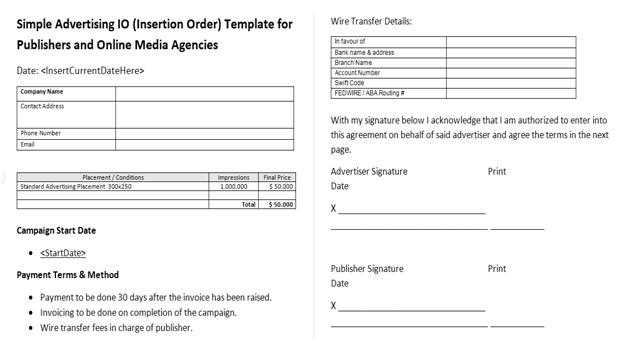An insertion order (IO) is a contract between an advertiser and a publisher that outlines the terms and conditions of an advertising campaign. Discover the benefits and drawbacks of using IOs, their role in advertising, and how they facilitate smooth collaborations between parties.
Back in the days of traditional advertising, most dealings were done manually. Publishers didn’t have standard terms and billing procedures. With time, as website monetization through display advertising increased, the industry started developing methods to keep records of the agreement. Hence we got an insertion order.
Why is it called an insertion order?
The term “Insertion Order” is used because it refers to the act of inserting or placing an advertisement into a specific media outlet or platform.
Why was the Insertion order introduced?
Publishers then lacked standardized terms and billing procedures, leading to potential inconsistencies and inefficiencies such as Inconsistent invoicing, unclear pricing, Miscommunication and misunderstandings, and more.
In today’s world, insertion orders are widely used by almost all publishers, advertisers, and ad tech agencies.
Without further ado, let’s dig deeper and understand what is an insertion order and its nitty-gritty.
What is an Insertion Order
Insertion order is an agreement containing the details of the inventory to ensure the ad proposal is processed. It guarantees that the advertiser can run ads on the publisher’s inventory. It is the last step in the inventory selling process issued by an advertiser, agency, or publisher also known as io marketing.
Moreover, this document contains all kinds of details related to the deal, which are:
- Name of campaign
- Start date and end date of the campaign
- Name and details of publisher
- Name and details of the advertiser
- Ad unit dimensions and placements
- Target audience to be covered
- Number of impressions to be served
- Pricing structure
- Ad sizes, colors, and positioning
- Total cost and discounts
- Reporting requirements
Insertion order or io marketing is an old-school method to keep a record of the advertising revenue. Even after digitization, insertion order continues in the industry and is still being practiced. It provides insight to both the publisher and advertiser about the ad placement.
Also Read – Programmatic Deals vs. Direct Deals
How to Create an Insertion Order?
You can find various templates for it online for free and paid. Also, IO templates can be designed in-house by adding the terms one would like to include in IO. If you use Google or Bing services, try Google’s or Bing’s way to create an insertion order.
While preparing for an insertion order, there are certain elements you must keep in mind.
Parties Involved
The IO entails information about the publisher and advertiser. So make sure you have clearly mentioned the advertiser and the publisher involved in the agreement with their respective names, business names, etc., properly.
Contact Information
Next, adding the contact information of both parties is a must. Generally, it is split into two sections. The first one includes the advertiser’s contact information, such as their name, phone number, website, address, email, etc.
The second section of the IO includes the billing contact of someone dealing with the payments.
Campaign Details
Specify the ad campaign start and end dates, including any specific timing requirements or schedules. As mentioned earlier, this can also be customized as long as the advertiser can understand all the details.
Ad Specifications
Include file format, size, animation limits, and creative guidelines to ensure compliance and quality. You should also consider including the audience segments, targeting locations, and anything the concerned party would want to know.
Here’s how an insertion order looks like-

Issuing Insertion Orders: Who Takes the Lead?
Creating an insertion order is not limited to any specific party; various entities, including publishers, advertisers, or agencies, can initiate it. The process is not constrained by a particular set of individuals. Now, let’s dive deeper into the concept of insertion orders and their significance. Now you must wonder how to create and what should be mentioned in the insertion order. Don’t worry; we got you covered.
Why Insertion Orders Matter in advertising campaigns?
Insertion orders (IOs) are pivotal in ensuring the seamless execution of advertising campaigns, benefiting both advertisers and publishers.
Here are key rationales underscoring their significance:
Clarity and Consensus
Mutual comprehension: IOs serve as formal agreements delineating essential campaign details such as commencement and culmination dates, budget allocation, ad layout, placement, and targeting criteria. This mutual reference document averts confusion and mitigates potential conflicts by ensuring alignment between parties.
Security and Assurance
Contractual obligation: By endorsing the IO, both parties commit to a legally binding agreement. This safeguards the interests of both advertisers and publishers, holding them accountable for fulfilling their respective commitments.
IOs also furnish publishers with assured income streams from advertising campaigns, facilitating efficient cash flow management. Advertisers benefit from pre-established insights into their campaign expenditure.
In terms of budgetary regulation, IOs commonly delineate pricing structures, whether fixed costs, cost-per-impression (CPM), or other models. This enables advertisers to exercise budgetary control and monitor campaign performance against predefined metrics.
Ultimately, insertion orders function as a roadmap for orchestrating successful advertising campaigns, safeguarding the interests of both advertisers and publishers while laying the groundwork for fruitful collaborations.
Let’s now have a look at the benefits an insertion order has to offer.
Benefits Of Insertion Order
Assurance of deal
For publishers, insertion order is the written proof of the deal. This contains the amount publisher will receive by selling the display inventory signed by the advertiser. Due to this, disagreements and conflicts can be avoided in the future.
Contains all details
It contains all the details related to the proposal (mentioned above) and publishers can easily access them. Using this, future pricing structures for inventory can be designed. Furthermore, io marketing helps in keeping the dealing records straight for future reference.
Customizable
Next, an IO gives the opportunity for publishers and advertisers to work together. Here both parties can negotiate and make a deal that is beneficial for both. Hence, for that, customization becomes an important step. The key is to make sure all details are understood and agreed by the parties involved, before signing off the IO.
No ad fraud
IO minimizes the chances of ad fraud. As the dealing is done manually where publishers, advertisers, and agencies sit together. The one-on-one contact among the parties brings out a sense of security for everyone involved.
Are There Any Drawbacks Of Insertion Order?
Yes, like most techs/features, the insertion order is not perfect either.
Makes the process slow
Insertion order requires constant human involvement. One person prepares the IO and another one approves it. And finally, the publisher and advertiser sit together to negotiate and sign it. These extra steps add more to the process, making it slow.
Negotiation can be tricky
No deal is perfect for both parties. One party has to compromise in order to seal a deal. The same thing happens when publishers and advertisers negotiate. The process is lengthy and there’s always a possibility that negotiation might not turn into a closed deal.
Not trending anymore
Programmatic deals are trending now. Both publishers and advertisers are appreciating automated methods. Because they’re easy, safe, and better in many ways. Reduced human involvement makes the process lightning fast, which eventually makes the publisher and advertisers opt for programmatic methods. Hence, all of this is shrinking the demand for direct deals and insertion orders.
There is no particular disadvantage to using IO. It just needs some technological updation to resolve above mentioned drawbacks.
Insertion Order: Best Practices For Publishers
- Insertion orders can be created by a publisher, advertiser, or agency. Generally, the
agency takes up the responsibility to document the IO. However, if no agency is involved, either publisher or advertiser can prepare the io marketing.
- IO is the documented proof of the ad proposal. Before signing it, publishers and advertisers should review it thoroughly to avoid disagreements.
- Insertion order is designed to be straightforward. However, if anything causes confusion, it’s advised to clear it up before signing the io marketing and beginning the campaign.
- For publishers, it’s ideal to store insertion orders in an organized way. This can help them later in the future when they’re needed for reference or audit purposes.
- It’s important for publishers to know their inventory. Do not oversell it by showing more impressions than you actually receive. Instead of giving a fixed number, publishers should specify a range based on historical data.
Are Insertion Orders Legal Binding or Informal Agreement?
Yes, an Insertion Order is a legally binding agreement. Any modifications to it necessitate written documentation and signatures from both parties.
This ensures clarity, transparency, and the enforceability of the contractual obligations outlined in the insertion order.
What is the Difference Between Insertion Order, Purchase Order, and Invoice?
Now that you know what an insertion order is, many questions must be coming into your mind, like:
What is the difference between an insertion order and a purchase order?
Is the insertion order the same as the invoice?
Here’s a table highlighting their key differences.
| Insertion Order | Purchase Order | Invoice | |
| Purpose | Advertising terms | Authorize goods | Request payment |
| Legal Status | Legally binding | Legally binding | Not binding |
| Content | Ad specifics | Goods/services | Goods/services |
| Timing | Before campaign | Before delivery | After delivery |
| Payment | No payment | Payment terms | Payment due |
Let’s understand the same closely.
Insertion Order
- Insertion orders are specifically used in the advertising industry.
- An Insertion Order specifies the terms and conditions for advertising campaigns.
- It ensures clarity and agreement between the advertiser and the publisher.
Purchase Order
- Purchase Orders are widely used across different sectors for deals between buyers and sellers.
- They outline what needs to be purchased to fulfill an order.
- Purchase Orders serve as an agreement and guide for both parties involved.
Invoice
- Invoices have a universal purpose and are used in various industries.
- Sellers issue them to buyers after purchase.
- Invoices record the transaction and indicate the buyer’s obligation to pay for the goods or services received.
By understanding the purpose of each document, we can distinguish their roles in different business transactions.
Insertion Order Template
The following is an insertion order template and should be customized according to the specific needs of your campaign. It is recommended to consult with legal counsel before finalizing and signing an insertion order.
This insertion order template provides a structured framework for documenting the essential details of an advertising campaign, including campaign specifics, budget, ad creative requirements, and additional terms and conditions.
Adjustments can be made to this insertion order template based on specific campaign requirements and agreements between the advertiser and the publisher.
| [Advertiser/Publisher Logo] |
| Insertion Order |
| Date: [Insert Date] |
| Advertiser: |
| [Advertiser Name] |
| [Advertiser Address] |
| [Advertiser Contact Information] |
| Publisher: |
| [Publisher Name] |
| [Publisher Address] |
| [Publisher Contact Information] |
| Campaign Details: |
| Campaign Name: [Insert Campaign Name] |
| Start Date: [Insert Start Date] |
| End Date: [Insert End Date] |
| Campaign Objective: [Insert Campaign Objective] |
| Target Audience: [Insert Target Audience Details] |
| Ad Format: [Insert Ad Format (e.g., display, video, native)] |
| Placement: [Insert Placement Details (e.g., website, app)] |
| Targeting Criteria: [Insert Targeting Criteria (e.g., demographics, interests)] |
| Budget: |
| Total Budget: [Insert Total Budget Amount] |
| Billing Method: [Insert Billing Method (e.g., CPM, CPC, flat fee)] |
| Pricing Structure: [Insert Pricing Structure Details (e.g., fixed cost, cost-per-impression)] |
| Payment Terms: [Insert Payment Terms (e.g., net 30, upon delivery)] |
| Ad Creative and Materials: |
| Ad Creative Specifications: [Insert Ad Creative Specifications (e.g., dimensions, file format)] |
| Delivery Deadline: [Insert Delivery Deadline for Ad Materials] |
| Creative Assets Provided by: [Advertiser/Publisher] |
| Additional Terms and Conditions: |
| Signature: |
| Advertiser Signature: ________________________ Date: ____________ |
| Publisher Signature: ________________________ Date: ___________ |
Here’s Why Programmatic Deals Are Winning
The advertising landscape is witnessing a significant shift towards programmatic deals, and for good reason.
Here are some key factors contributing to their growing popularity:
Efficiency and Automation:
- Streamlined Workflow: Programmatic deals automate the ad buying and selling process, eliminating the need for manual negotiations and paperwork. This translates to faster campaign setup, reduced operational costs, and improved efficiency for both advertisers and publishers.
- Data-Driven Targeting: By leveraging sophisticated algorithms and audience data, programmatic deals enable precise targeting, ensuring ads reach the most relevant users, potentially leading to higher engagement and campaign effectiveness.
Transparency and Control:
- Greater Control: Programmatic deals offer advertisers more control over their campaigns. They can set specific targeting parameters, define budgets, and choose the type of inventory they want to access, like guaranteed deals for assured impressions or private marketplaces for premium ad placements.
- Enhanced Transparency: Unlike traditional methods, programmatic deals provide advertisers with detailed insights into campaign performance, allowing them to optimize their strategies in real-time and make data-driven decisions.
Benefits for Both Sides:
- Predictable Revenue: Publishers benefit from the predictability offered by programmatic deals, as they can secure a set amount of revenue upfront through guaranteed deals. This streamlines their cash flow and financial planning.
- Premium Inventory Access: Advertisers gain access to premium ad inventory that might not be available through open exchanges, potentially enhancing brand image and campaign impact.
Overall, programmatic deals offer a win-win situation for both advertisers and publishers by:
- Enhancing efficiency and automation
- Enabling data-driven targeting and optimization
- Providing greater control and transparency
- Securing predictable revenue and premium ad access
While traditional direct deals still hold importance, the flexibility, efficiency, and data-driven approach of programmatic deals are shaping the future of advertising and are likely to continue their rise in popularity.
This Is Why Programmatic Is the Future
In the present, programmatic advertising stands as the future of advertising due to its unparalleled efficiency, precision, and scalability. By automating the ad buying process, programmatic platforms streamline campaign management, saving advertisers time and resources. Moreover, the use of vast amounts of data enables precise targeting of specific audience segments, resulting in more relevant and effective ad placements. Real-time optimization further enhances campaign performance by allowing advertisers to make data-driven decisions on the fly.
With access to a vast inventory of digital ad space across various channels, programmatic advertising offers unmatched reach and scale, ensuring maximum exposure for brands. Additionally, the transparency provided by programmatic platforms allows advertisers to accurately measure campaign performance and optimize their ad spend accordingly. This cost-effectiveness, coupled with the ability to seamlessly integrate across multiple channels and devices, makes programmatic advertising a compelling choice for advertisers looking to engage consumers in innovative ways. As technology continues to evolve, programmatic advertising remains at the forefront of advertising, driving continued innovation and evolution in the industry.
Conclusion
Insertion order may sound like an extra step, sometimes even hectic. But in order to run a fair and monitored business, io marketing can be really helpful. It’s a step in the advertisement process, which represents a commitment between advertisers and publishers.
IO helps to manage the budget for advertisers. And for publishers, it can be used to evaluate generated revenue. Most importantly, IO keeps things tidy for everyone.
Frequently Asked Questions: Insertion Order
Insertion order is a contract between an advertiser and a publisher for running ad campaigns, It guarantees that the advertiser can run ads on the publisher’s inventory.
Some of the benefits of insertion order are:
It provides assurance of a deal
It contains all details
It is customizable
No ad fraud
There is no particular disadvantage of using IO. However, you can keep few things in mind:
It makes the process slow
Negotiation can be tricky
It is not trending anymore

Deepak has a keen eye for detail and a deep understanding of the ad tech landscape. Whether it’s through in-depth articles, thought-provoking insights, or compelling storytelling, he’s dedicated to helping people navigate the complex world of ad tech with the simplicity of his words.




![CTV vs OTT Advertising: Which one is Right Pick for Publishers? + [6 Bonus Strategies] Ott vs Ctv](png/featured-image-270x180.png)


